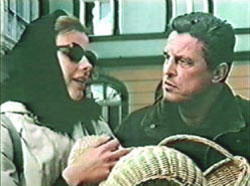
Eduks (Ivars Kalniņš) is reunited with his student, Agnese (Agnese Zeltiņa), in the streets of Old Rīga.
Likteņdzirnas is a flawed film that manages to capture the spirit of the years shortly following Latvian independence—despite its tendency towards overwrought sentimentality and substandard production values.
Eduks (Ivars Kalniņš) is a college professor caught between the reality of the present and the desire to regain the past. He has inherited a mill. To him the mill holds priceless sentimental value. To his ex-wife and children the mill has only monetary value. He wants to restore the mill to its former glory and live happily ever after in its pastoral setting. Everyone else is pressuring him to sell it and get all that he can while he can. There is no shortage of buyers, including Vincent (Romualds Ancāns), a quasi-Mafiosi who wants to turn the mill into a Roman bath and brothel. Eduks is joined in his struggle to restore the old mill by Agnese (Agnese Zeltiņa) and Beisiks (Artūrs Skrastiņš). Agnese is an old student of his who, in a twist of fate, had lost her eyesight. Beisiks is a young musician wandering from job to job who knows every Latvian folk song, but dresses like a Metallica groupie.
This broad soap opera outline is symbolic of all that was happening in Latvia at the time and, to a point, is continuing in the present day. Shortly after independence, as people reclaimed properties usurped by the Soviets, similar real-life stories were played out all over Latvia. The joy of our regained independence often had to take a back seat to the need to live and the desire to thrive in a capitalist society. This was a society in which traditional Latvian values at times clashed head on with the realties of having to make a buck.
Eduks represents the idealized model of what a Latvian is: strong, stoic and with a lyrical love of the land. He is always willing to do the right thing. Vincent symbolizes the forces of change that were sweeping through the nation. He borders the fine line between a legitimate businessman and an old fashioned crime boss. Beisiks symbolizes the lost youth of the current generation: aimless and fatalistic, proud of his heritage while adopting the mannerisms and language of Western culture, trying to bridge the two into one. Agnese represents the Latvians who have decided to make the best of what they have despite all of the obstacles.
Likteņdzirnas is not a great film, but it is a good one. Director Jānis Streičs starts off slowly, but eventually manages to create a believable story full of lyricism and warmth. However, what really makes the film work is the performances of the actors, primarily of Skrastiņš. Skrastiņš manages to capture the dichotomy of Latvian youth, caught in a mess that was not of their making and persevering with a combination of fatalistic resignation and youthful exuberance and optimism. Kalniņš brings just the right note of soul to Eduks without, as often happens in Latvian films, making him seem overly dramatic and brooding.
This film could have easily have turned into a heavy melodrama, but in the end it manages to tell its story with humor and warmth. It captures the hardships of adjusting to a new world and manages to show the difficulty of reconciling our expectations with the realities of life. There is a bit of these characters in all of us.
(Editor’s note: This review originally appeared on author Andrejs Makwitz’s Web site, The Latvian Film Page, and is republished with permission.)
Details
Likteņdzirnas
Jānis Štreics
National Film Center of Latvia, 1997
Notes: In Latvian. Drama, color, 105 minutes. Screenplay: Jānis Streičs; director of photography: Harijs Kukels; producer: Uldis Šteins; music: Raimonds Pauls; set design: Ieva Romānova; editor: Maija Indersone; sound: Viktors Ličovs; principal cast: Ivars Kalniņš, Agnese Zeltiņa, Artūrs Skrastiņš and Romualds Ancāns.
© 1995-2024 Latvians Online
Please contact us for editorial queries, or for permission to republish material. Disclaimer: The content of Web sites to which Latvians Online provides links does not necessarily reflect the opinion of Latvians Online, its staff or its sponsors.





There are some mistakes even by retelling of the storyline in this review of the movie, so also all the assertions concerning what who represents in this movie are quite inadequate and taken to easy. For exemple, please, tell us, where can you see that Vincent wants to buy the mill and that he “borders the fine line between a legitimate businessman and an old fashioned crime boss”? All you can see in this very movie is that he is a painter, an artist who comes to the mill to spend there a summer and to escape an excess of drinking of alcohol. Not a slightest signal of what you affirm here. He also goes on a pilgrimage to Aglona together with others and has nothing to do with mafia. The author of this review needs certanly to see the movie again. “Beisiks is a young musician wandering from job to job who knows every Latvian folk song, but dresses like a Metallica groupie.” Have you ever seen folk or pagan metal bands as Latvian “Skyforger” to see, that metal outfit fits sometimes very well with singing folksongs? Or at least, there is no objective discrepance. So is there really inadequance in the movie in this case or in the review?